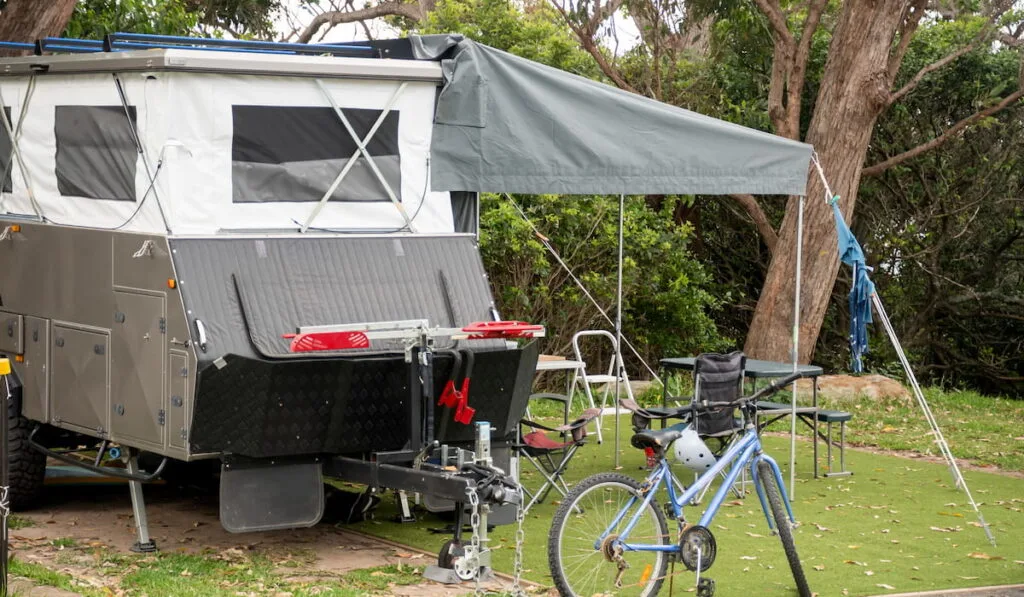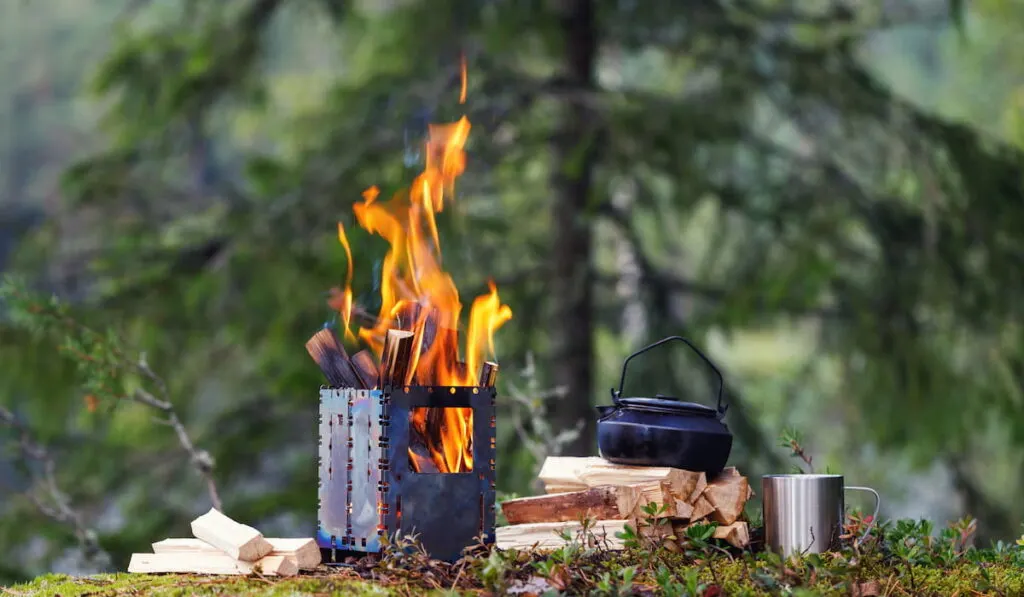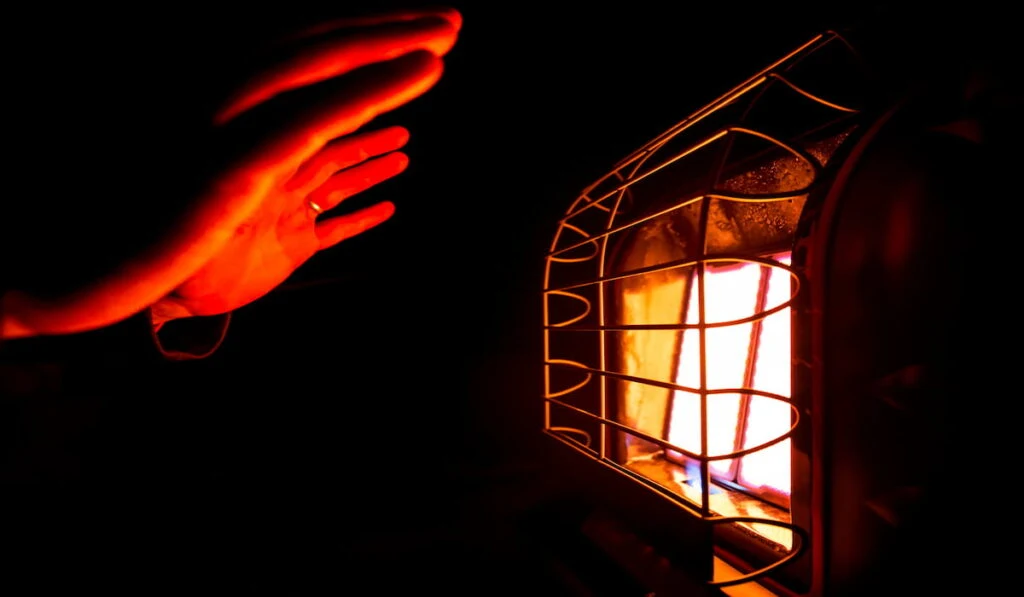Pop-up campers are a versatile and affordable way to camp as you go. They don’t come with all of the latest features like Class A RVs do, but they also don’t come with outrageous price tags.
If you’re camping or don’t have access to electricity, you will have to find different ways to heat your pop-up camper. When you’re off the grid, some of the easiest ways to heat the camper include using portable heaters, staying in the sun, and buying a small wood stove.

In a small space, portable solutions are surprisingly effective. They’ll keep you and anyone else inside warm. You’ll also probably want to wear layers and use blankets depending on where you are and how cold it is outside.
If you’re planning a trip somewhere chilly in a pop-up camper and you’re worried about staying warm, here’s a guide to how you can heat things up without electricity.
Table of Contents
Safety First
Portable solutions typically do an excellent job heating small spaces. While there are small and large pop-up campers, most of them are small enough that a portable electric heater would keep you and everyone else warm inside if you had access to electricity.
In severely cold temperatures, you may need multiple heat sources, but something like a wood stove will do an excellent job keeping everyone nice and toasty.
However, when camping in the pop-up, you must remember that portable heating solutions usually come with some safety risks. This is because the heat has to come from somewhere, which often involves burning something, whether it’s wood, gas, or some other fuel.
Plugging in is always a safer bet.
It’s one of the main reasons why so many campgrounds across the country restrict fires and provide electrical outlets to campers and RV owners.
Unfortunately, heating with electricity isn’t always an option. If you’re using one of the portable heating solutions we discuss below, ensure you’re paying close attention to safety precautions to keep everyone warm and happy.

Wood Stoves Generate a Ton of Heat
In small spaces, wood stoves are incredibly effective. People use them all the time to heat tents, small cabins, and pop-up campers. If you look online or at your local outdoor supply store, you’ll see plenty of options in different sizes.
The main thing you need to remember with wood stoves is that you need dry wood! That’s not always easy if you’re camping somewhere wet and dark.
Trying to burn soaked wood is an exercise in futility, so you’ll need to store enough dry firewood to get you through those freezing nights.
Wood stoves aren’t large, so you don’t typically need a great deal of wood.
However, wood-burning stoves require constant attention to maintain heat levels in a pop-up camper. So if you light the fire and forget it, you’ll always be adding wood when it’s cold and waiting for things to heat back up.
They will, however, keep the pop-up camper you’re in very warm. Wood stoves are fantastic at generating heat because the fire gets hot and heats the casing, radiating heat throughout the camper.
How to Reduce Fire Risks?
You’ll need a board or some barrier between the stove and the surfaces under and behind it to stay safe. A heat-resistant or stone board will stop the stove from only heating the area around it (potentially to the point of melting or burning it) and send the heat outward into the camper.
You’ll also need to use a mini wood stove and keep it as far away from your camper roof as possible. Too much heat on the roof of a pop-up camper is a fire hazard, and you don’t want to melt your roof and be left camping under the stars.
You’ll also need to deal with smoke from a wood stove. This may not be an issue for smaller stoves, but larger ones tend to generate a lot of smoke.
Most of the portable wood stoves come with flues that you can install to funnel smoke out of the door or a window to keep your camper smoke-free.
Wood stoves are also relatively affordable and easy to use; a great option for people who want something basic but effective.

Using Propane to Warm Your Camper
Everywhere around the world, campers rely on propane to fuel stoves, generators, and other appliances. There are propane stations across America where filling up tanks and canisters for your fuel needs is relatively affordable.
Portable propane heaters are a nice option for people who need to heat up a pop-up camper without electricity. The only real concern with propane is that you’ll need to find a way for fumes to escape your camper.
Propane heaters come in different sizes and heating capacities. Be sure to read their recommended heating area to find one suitable for your camper.
You’ll also need a long enough hose to reach your main propane tank or a smaller one that you purchase specifically for your heater.
Do not run a propane heater without sufficient ventilation; you can die from inhaling the fumes.
Most of these heaters release carbon monoxide, so you must find a way to funnel those fumes outdoors. You can do this by opening a window where the fumes can find their way outside.
You should also install a carbon monoxide monitor in your camper since the gas is colorless and odorless.
Trapping Your Body Heat to Stay Warm
If you’re new to camping, you’ll quickly discover how important it is to keep your body temperature high and make use of the warmth your body generates.
In a small pop-up camper, you and any guests with you will be putting off a decent amount of heat in a small space. So naturally, you’ll want to make use of that heat.
One of the easiest ways to trap body heat is to stay wrapped up. Put on more clothes and make good use of blankets.
However, you’ll wish you had something more when things get cold outside.
Planning ahead and making sure your camper is well-insulated will keep you warmer when things feel frigid outside.
Here’s how you can improve your pop-up camper’s insulation to stay warmer inside:
Buy Insulated Panels
Insulated panels are affordable and easy to buy.
Insulated panels are reflective panels that you put up in windows to keep heat inside. As warm air tries to escape through doorways, windows, and cracks, it hits the reflective panels and bounces back indoors.
Insulated panels are usually made of foil and are easy to store underneath a bed or bench.
Eliminate Cracks
Whether you’re buying a second-hand camper or have been using your pop-up for years, you need to check it for cracks and openings before you take it cold-weather camping.
Window areas are one of the main culprits when it comes to heating escaping, so open your camper and go over the windows and other seals with a caulk gun to eliminate holes.
Cover Your Floors
This is something that a lot of campers overlook. Floors tend to get very cold in campers.
This is because they are closer to the ground and are often made of plastic, linoleum, or some other cool material. Heating them up is hard.
A simple solution to heating your pop-up camper without electricity is buying a rug or using blankets to cover the floor. It’s another layer of insulation that will trap heat inside and help you feel warmer.
Buy Cold-Weather Gear

Using gear that’s made for colder weather will help you stay toasty inside.
For example, you can wear flannel clothes, buy premium down jackets and blankets, flannel sheets, and heating pads.
Putting hot water bottles into your blankets before you sleep is a terrific way to warm up your bed, and, of course, you should be sleeping in a thermal sleeping bag when it’s cold outside.
Using the right equipment can bypass the need for external heating sources in all but the coldest conditions. For example, when wearing flannel clothes in a camper set up with insulation panels and blankets, you can stay warm without burning wood or using a propane heater.
Portable Solar Panels
Not having access to an outlet doesn’t necessarily mean you can’t heat your pop-up camper without electricity. If you have the money to spend, you can always buy portable solar panels and batteries to store the sun’s energy for later in the day when things get cold.
The only issue with solar is that the amount of power you get will depend on sun exposure. In the winter, it can be hard to get direct sunlight, or at least enough sunlight to power any electrical space heater through the night.
Conclusion: Heating Pop-Up Campers Can Be Challenging
You don’t see many pop-up campers out in the cold because they’re usually tough to keep warm.
The thin walls that make them so convenient to tow around make it hard to keep heat inside. Still, using the above solutions will help keep things warmer and open up more camping options for you.
Above all, stay safe and do your best to buy clothing and other supplies to keep you warm naturally before looking for external heat sources.
